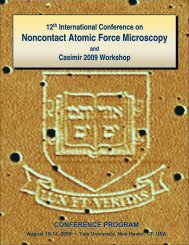Circuit Quantum Electrodynamics - Yale School of Engineering ...
Circuit Quantum Electrodynamics - Yale School of Engineering ...
Circuit Quantum Electrodynamics - Yale School of Engineering ...
You also want an ePaper? Increase the reach of your titles
YUMPU automatically turns print PDFs into web optimized ePapers that Google loves.
CHAPTER 2. CAVITY QUANTUM ELECTRODYNAMICS 35<br />
g<br />
γ ⊥ T transit<br />
from quantum optics group at CalTech<br />
Figure 2.1: A two level atom interacts with the field inside <strong>of</strong> a high finesse cavity. The atom<br />
coherently interacts with the cavity at a rate, g. Also present are decoherence processes that allow<br />
the photon to decay at rate κ, the atom to decay at rate γ⊥ into modes not trapped by the cavity,<br />
and the rate at which the atom leaves the cavity, 1/T. To reach the strong coupling limit the<br />
interaction strength must larger than the rates <strong>of</strong> decoherence g > κ, γ⊥, 1/Ttransit.<br />
leakage or absorption by the cavity results in a photon decay rate, κ, sometimes expressed in terms<br />
<strong>of</strong> the quality factor Q = ωr/κ. Often, and particularly in circuit QED, κ is set by the desired<br />
transparency <strong>of</strong> the mirrors to allow some light to be transmitted to a detector as a means <strong>of</strong><br />
probing the dynamics <strong>of</strong> the system. In the absence <strong>of</strong> other decay mechanisms, the radiative decay<br />
<strong>of</strong> the atom can be completely described in terms <strong>of</strong> the coherent interaction with the cavity and<br />
decay <strong>of</strong> cavity photons (which are measured). This very well modeled (and <strong>of</strong>ten slow) decay makes<br />
cavity QED a good test-bed for studying quantum measurement and open systems [Mabuchi2002].<br />
In practice, the atom may also decay at rate, γ⊥, into non-radiative channels or radiative modes<br />
not captured by the cavity. Finally in atomic implementations, the atoms have a finite lifetime or<br />
transit time Ttransit, before exiting the cavity.<br />
The competition between coherent and incoherent processes is most evident when the atom is<br />
resonant with the cavity, and the two systems can freely exchange energy. In the absence <strong>of</strong> decay, an<br />
excitation placed in the system will coherently oscillate between an atomic excitation and a photon<br />
in the cavity. This is <strong>of</strong>ten called a vacuum Rabi oscillation because it can be interpreted as vacuum<br />
fluctuations which stimulate photon emission and absorption by the atom to and from the cavity.<br />
When many oscillations can be completed before the atom decays or the photon is lost, the system<br />
reaches the strong coupling limit <strong>of</strong> cavity QED (g > γ⊥, κ, 1/Ttransit).<br />
κ















